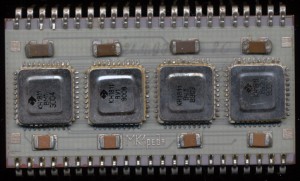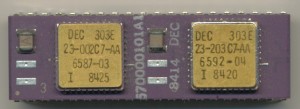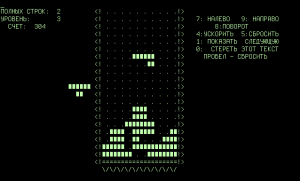The Electronika MK1 red3 PDP-11 Chipset and Tetris
The DEC F-11 ‘Fonz’ implementation of the PDP-11 was released in 1979 and was DEC’s second ‘LSI’ implementation of the PDP. Like its predecessor it was a multi-chip implementation, consisting at its root of a data chip (DC302) and 1-9 control chips (DC303). The DC303 control chips were essentially a large ROM/PLA with a few extra features added for interrupts and sequencing. They formed the microcoded instruction set that drove the 16-bit ALU and registers of the DC302. This is why more then one were supported. Expanding the instruction set was as ‘simple’ as adding more DC303 chips with these instructions encoded. The basic LSI11/23 came with one 303 and one 302. A second IC could be added to support floating point, which included a pair of DC303 chips implementing the floating point instructions. A MMU (DC304) was also supported, and required when using the FP option.
The Soviets also widely adopted the PDP-11 architecture. Likely because it was designed to be rather hardware independent. It could be implemented in many different ways, which meant the Soviets could adopt/implement it on their own. Electronika was part of the Soviet industrial complex in Voronezh, Russia making many different IC’s, but also was tasked with making consumer devices (computers and calculators etc, that were in very short supply. The Electronika 60 was one of the first PDP-11 computers they made, and it implemented a copy of the DEC Fonz processor. Electronika combined the standard chipset, and FPU onto a single large MCM with all 4 IC’s (the MMU remained separate) called the MK1 red1 (and later the MK1 red3)
KH1811VM1 = DC302 – 21-15541 Data Chip (16-bit ALU etc)
KH1811VU1 = DC303 – 23-001C7 standard instruction set
KH1811VU2 = DC303 – 23-002C7 FP instruction set Part 1
KH1811VU3 = DC303 – 23-003C7 FP instruction set Part 2
It was on this chipset, on a Soviet Electronika 60 that Alexey Pajitnov wrote the very first version of the still famous game of Tetris back in 1984. A game that was very popular, and very widely copied in the West, even to this day. (the copying of technology most certainly went both ways)
Posted in:
CPU of the Day




